The Basics of Climate Change
Greenhouse gases affect Earth’s energy balance and climate
The Sun serves as the primary energy source for Earth’s climate. Some of the incoming sunlight is reflected directly back into space, especially by bright surfaces such as ice and clouds, and the rest is absorbed by the surface and the atmosphere. Much of this absorbed solar energy is re-emitted as heat (longwave or infrared radiation). The atmosphere in turn absorbs and re-radiates heat, some of which escapes to space. Any disturbance to this balance of incoming and outgoing energy will affect the climate. For example, small changes in the output of energy from the Sun will affect this balance directly.
If all heat energy emitted from the surface passed through the atmosphere directly into space, Earth’s average surface temperature would be tens of degrees colder than today. Greenhouse gases in the atmosphere, including water vapour, carbon dioxide, methane, and nitrous oxide, act to make the surface much warmer than this because they absorb and emit heat energy in all directions (including downwards), keeping Earth’s surface and lower atmosphere warm [Figure B1]. Without this greenhouse effect, life as we know it could not have evolved on our planet. Adding more greenhouse gases to the atmosphere makes it even more effective at preventing heat from escaping into space. When the energy leaving is less than the energy entering, Earth warms until a new balance is established.
Greenhouse gases emitted by human activities alter Earth’s energy balance and thus its climate. Humans also affect climate by changing the nature of the land surfaces (for example by clearing forests for farming) and through the emission of pollutants that affect the amount and type of particles in the atmosphere.
Scientists have determined that, when all human and natural factors are considered, Earth’s climate balance has been altered towards warming, with the biggest contributor being increases in CO2.
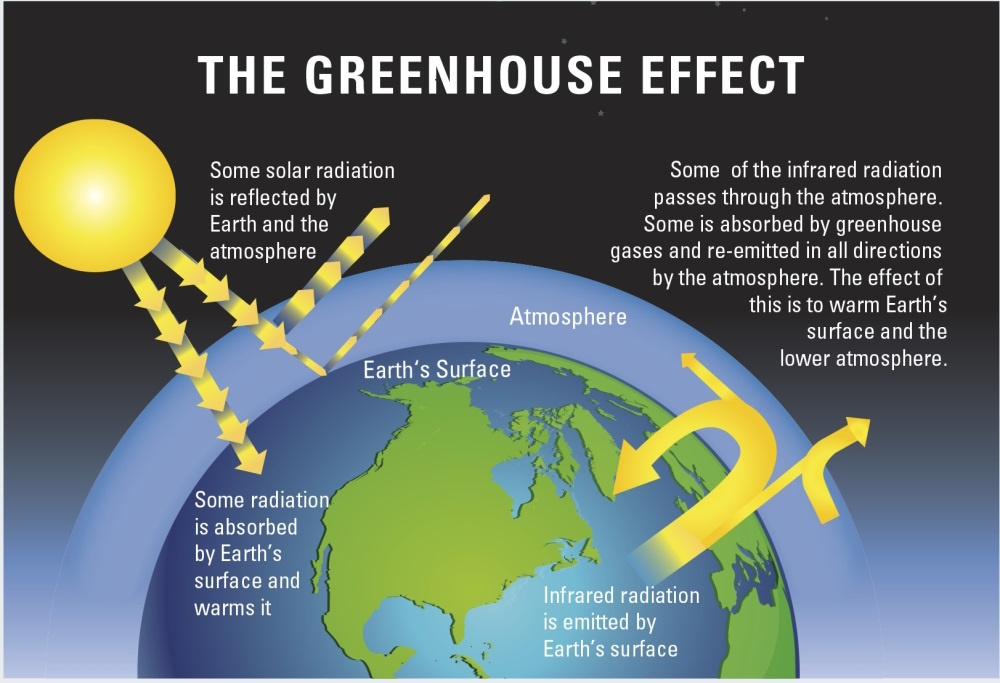
Figure b1. Greenhouse gases in the atmosphere, including water vapour, carbon dioxide, methane, and nitrous oxide, absorb heat energy and emit it in all directions (including downwards), keeping Earth’s surface and lower atmosphere warm. Adding more greenhouse gases to the atmosphere enhances the effect, making Earth’s surface and lower atmosphere even warmer. Image based on a figure from US EPA.
Human activities have added greenhouse gases to the atmosphere
The atmospheric concentrations of carbon dioxide, methane, and nitrous oxide have increased significantly since the Industrial Revolution began. In the case of carbon dioxide, the average concentration measured at the Mauna Loa Observatory in Hawaii has risen from 316 parts per million (ppm) in 1959 (the first full year of data available) to more than 411 ppm in 2019 [Figure B2]. The same rates of increase have since been recorded at numerous other stations worldwide. Since preindustrial times, the atmospheric concentration of CO2 has increased by over 40%, methane has increased by more than 150%, and nitrous oxide has increased by roughly 20%. More than half of the increase in CO2 has occurred since 1970. Increases in all three gases contribute to warming of Earth, with the increase in CO2 playing the largest role. See page B3 to learn about the sources of human emitted greenhouse gases. Learn about the sources of human emitted greenhouse gases.
Scientists have examined greenhouse gases in the context of the past. Analysis of air trapped inside ice that has been accumulating over time in Antarctica shows that the CO2 concentration began to increase significantly in the 19th century [Figure B3], after staying in the range of 260 to 280 ppm for the previous 10,000 years. Ice core records extending back 800,000 years show that during that time, CO2 concentrations remained within the range of 170 to 300 ppm throughout many “ice age” cycles - learn about the ice ages - and no concentration above 300 ppm is seen in ice core records until the past 200 years.
Measurements of the forms (isotopes) of carbon in the modern atmosphere show a clear fingerprint of the addition of “old” carbon (depleted in natural radioactive 14C) coming from the combustion of fossil fuels (as opposed to “newer” carbon coming from living systems). In addition, it is known that human activities (excluding land use changes) currently emit an estimated 10 billion tonnes of carbon each year, mostly by burning fossil fuels, which is more than enough to explain the observed increase in concentration. These and other lines of evidence point conclusively to the fact that the elevated CO2 concentration in our atmosphere is the result of human activities.
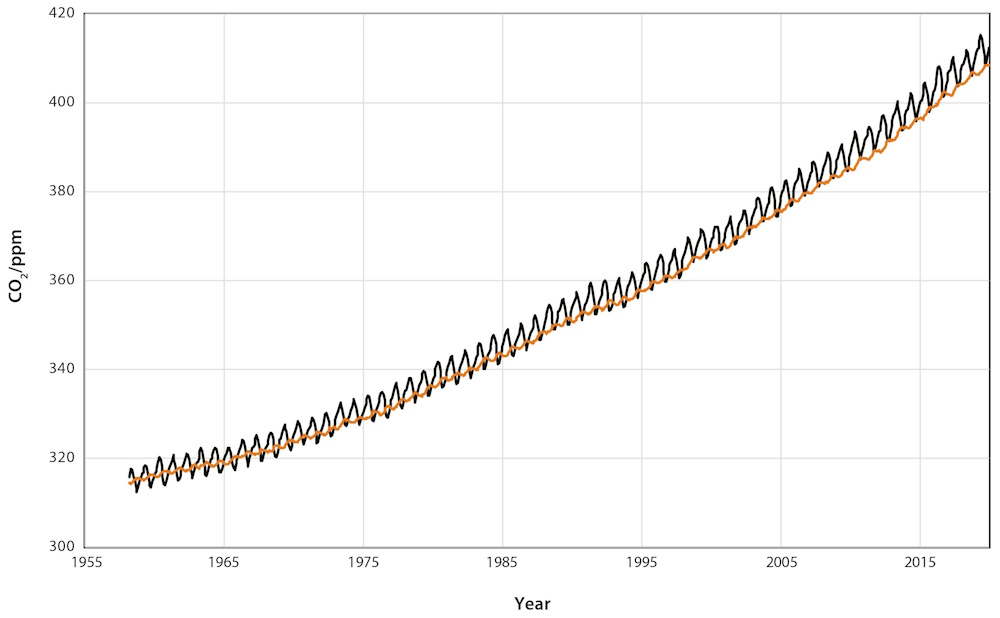
Fig b2. Measurements of atmospheric CO2 since 1958 from the Mauna Loa Observatory in Hawaii (black) and from the South Pole (red) show a steady annual increase in atmospheric CO2 concentration. The measurements are made at remote places like these because they are not greatly influenced by local processes, so therefore they are representative of the background atmosphere. The small up-and-down saw-tooth pattern reflects seasonal changes in the release and uptake of CO2 by plants. Source: Scripps CO2 Program
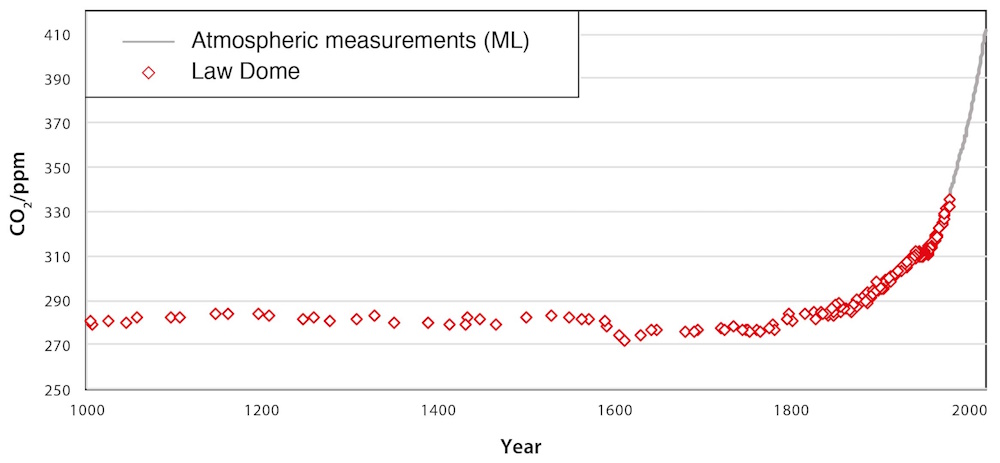
Figure b3. CO2 variations during the past 1,000 years, obtained from analysis of air trapped in an ice core extracted from Antarctica (red squares), show a sharp rise in atmospheric CO2 starting in the late 19th century. Modern atmospheric measurements from Mauna Loa are superimposed in gray. Source: figure by Eric Wolff, data from Etheridge et al., 1996; MacFarling Meure et al., 2006; Scripps CO2 Program.
Climate records show a warming trend
Estimating global average surface air temperature increase requires careful analysis of millions of measurements from around the world, including from land stations, ships, and satellites. Despite the many complications of synthesising such data, multiple independent teams have concluded separately and unanimously that global average surface air temperature has risen by about 1 °C (1.8 °F) since 1900 [Figure B4]. Although the record shows several pauses and accelerations in the increasing trend, each of the last four decades has been warmer than any other decade in the instrumental record since 1850.
Going further back in time before accurate thermometers were widely available, temperatures can be reconstructed using climate-sensitive indicators “proxies” in materials such as tree rings, ice cores, and marine sediments. Comparisons of the thermometer record with these proxy measurements suggest that the time since the early 1980s has been the warmest 40-year period in at least eight centuries, and that global temperature is rising towards peak temperatures last seen 5,000 to 10,000 years ago in the warmest part of our current interglacial period.
Many other impacts associated with the warming trend have become evident in recent years. Arctic summer sea ice cover has shrunk dramatically. The heat content of the ocean has increased. Global average sea level has risen by approximately 16 cm (6 inches) since 1901, due both to the expansion of warmer ocean water and to the addition of melt waters from glaciers and ice sheets on land. Warming and precipitation changes are altering the geographical ranges of many plant and animal species and the timing of their life cycles. In addition to the effects on climate, some of the excess CO2 in the atmosphere is being taken up by the ocean, changing its chemical composition (causing ocean acidification).
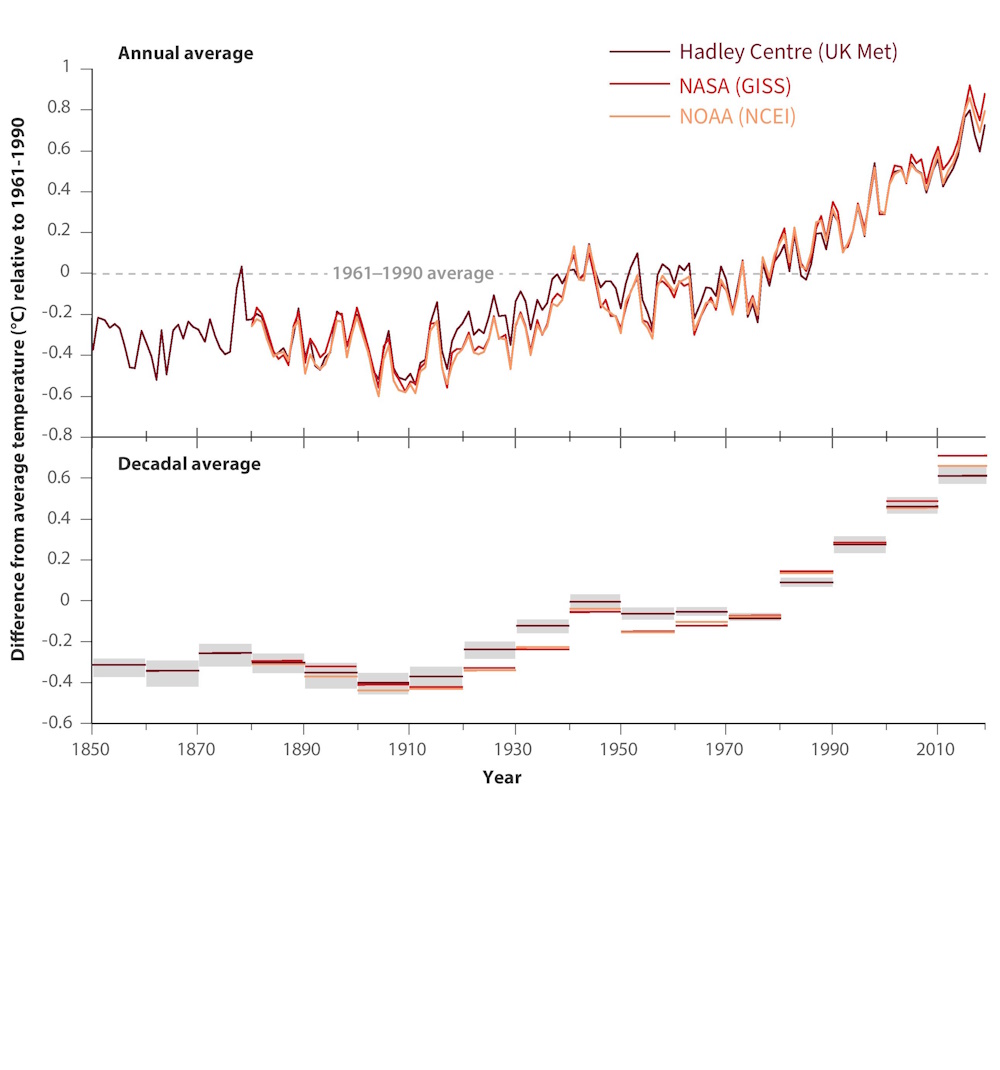
Figure b4. Earth’s global average surface temperature has risen, as shown in this plot of combined land and ocean measurements from 1850 to 2019 derived from three independent analyses of the available data sets. The top panel shows annual average values from the three analyses, and the bottom panel shows decadal average values, including the uncertainty range (grey bars) for the maroon (HadCRUT4) dataset. The temperature changes are relative to the global average surface temperature, averaged from 1961−1990. Source: Based on IPCC AR5, data from the HadCRUT4 dataset (black), NOAA Climate.gov; data from UK Met Office Hadley Centre (maroon), US National Aeronautics and Space Administration Goddard Institute for Space Studies (red), and US National Oceanic and Atmospheric Administration National Centers for Environmental Information (orange).
Many complex processes shape our climate
Based just on the physics of the amount of energy that CO2 absorbs and emits, a doubling of atmospheric CO2 concentration from pre-industrial levels (up to about 560 ppm) would by itself cause a global average temperature increase of about 1 °C (1.8 °F). In the overall climate system, however, things are more complex; warming leads to further effects (feedbacks) that either amplify or diminish the initial warming.
The most important feedbacks involve various forms of water. A warmer atmosphere generally contains more water vapour. Water vapour is a potent greenhouse gas, thus causing more warming; its short lifetime in the atmosphere keeps its increase largely in step with warming. Thus, water vapour is treated as an amplifier, and not a driver, of climate change. Higher temperatures in the polar regions melt sea ice and reduce seasonal snow cover, exposing a darker ocean and land surface that can absorb more heat, causing further warming. Another important but uncertain feedback concerns changes in clouds. Warming and increases in water vapour together may cause cloud cover to increase or decrease which can either amplify or dampen temperature change depending on the changes in the horizontal extent, altitude, and properties of clouds. The latest assessment of the science indicates that the overall net global effect of cloud changes is likely to be to amplify warming.
The ocean moderates climate change. The ocean is a huge heat reservoir, but it is difficult to heat its full depth because warm water tends to stay near the surface. The rate at which heat is transferred to the deep ocean is therefore slow; it varies from year to year and from decade to decade, and it helps to determine the pace of warming at the surface. Observations of the sub-surface ocean are limited prior to about 1970, but since then, warming of the upper 700 m (2,300 feet) is readily apparent, and deeper warming is also clearly observed since about 1990.
Surface temperatures and rainfall in most regions vary greatly from the global average because of geographical location, in particular latitude and continental position. Both the average values of temperature, rainfall, and their extremes (which generally have the largest impacts on natural systems and human infrastructure), are also strongly affected by local patterns of winds.
Estimating the effects of feedback processes, the pace of the warming, and regional climate change requires the use of mathematical models of the atmosphere, ocean, land, and ice (the cryosphere) built upon established laws of physics and the latest understanding of the physical, chemical and biological processes affecting climate, and run on powerful computers. Models vary in their projections of how much additional warming to expect (depending on the type of model and on assumptions used in simulating certain climate processes, particularly cloud formation and ocean mixing), but all such models agree that the overall net effect of feedbacks is to amplify warming.
Human activities are changing the climate
Rigorous analysis of all data and lines of evidence shows that most of the observed global warming over the past 50 years or so cannot be explained by natural causes and instead requires a significant role for the influence of human activities.
In order to discern the human influence on climate, scientists must consider many natural variations that affect temperature, precipitation, and other aspects of climate from local to global scale, on timescales from days to decades and longer. One natural variation is the El Niño Southern Oscillation (ENSO), an irregular alternation between warming and cooling (lasting about two to seven years) in the equatorial Pacific Ocean that causes significant year-to-year regional and global shifts in temperature and rainfall patterns. Volcanic eruptions also alter climate, in part increasing the amount of small (aerosol) particles in the stratosphere that reflect or absorb sunlight, leading to a short-term surface cooling lasting typically about two to three years. Over hundreds of thousands of years, slow, recurring variations in Earth’s orbit around the Sun, which alter the distribution of solar energy received by Earth, have been enough to trigger the ice age cycles of the past 800,000 years.
Fingerprinting is a powerful way of studying the causes of climate change. Different influences on climate lead to different patterns seen in climate records. This becomes obvious when scientists probe beyond changes in the average temperature of the planet and look more closely at geographical and temporal patterns of climate change. For example, an increase in the Sun’s energy output will lead to a very different pattern of temperature change (across Earth’s surface and vertically in the atmosphere) compared to that induced by an increase in CO2 concentration. Observed atmospheric temperature changes show a fingerprint much closer to that of a long-term CO2 increase than to that of a fluctuating Sun alone. Scientists routinely test whether purely natural changes in the Sun, volcanic activity, or internal climate variability could plausibly explain the patterns of change they have observed in many different aspects of the climate system. These analyses have shown that the observed climate changes of the past several decades cannot be explained just by natural factors.
How will climate change in the future?
Scientists have made major advances in the observations, theory, and modelling of Earth’s climate system, and these advances have enabled them to project future climate change with increasing confidence. Nevertheless, several major issues make it impossible to give precise estimates of how global or regional temperature trends will evolve decade by decade into the future. Firstly, we cannot predict how much CO2 human activities will emit, as this depends on factors such as how the global economy develops and how society’s production and consumption of energy changes in the coming decades. Secondly, with current understanding of the complexities of how climate feedbacks operate, there is a range of possible outcomes, even for a particular scenario of CO2 emissions. Finally, over timescales of a decade or so, natural variability can modulate the effects of an underlying trend in temperature. Taken together, all model projections indicate that Earth will continue to warm considerably more over the next few decades to centuries. If there were no technological or policy changes to reduce emission trends from their current trajectory, then further globally-averaged warming of 2.6 to 4.8 °C (4.7 to 8.6 °F) in addition to that which has already occurred would be expected during the 21st century [Figure B5]. Projecting what those ranges will mean for the climate experienced at any particular location is a challenging scientific problem, but estimates are continuing to improve as regional and local-scale models advance.
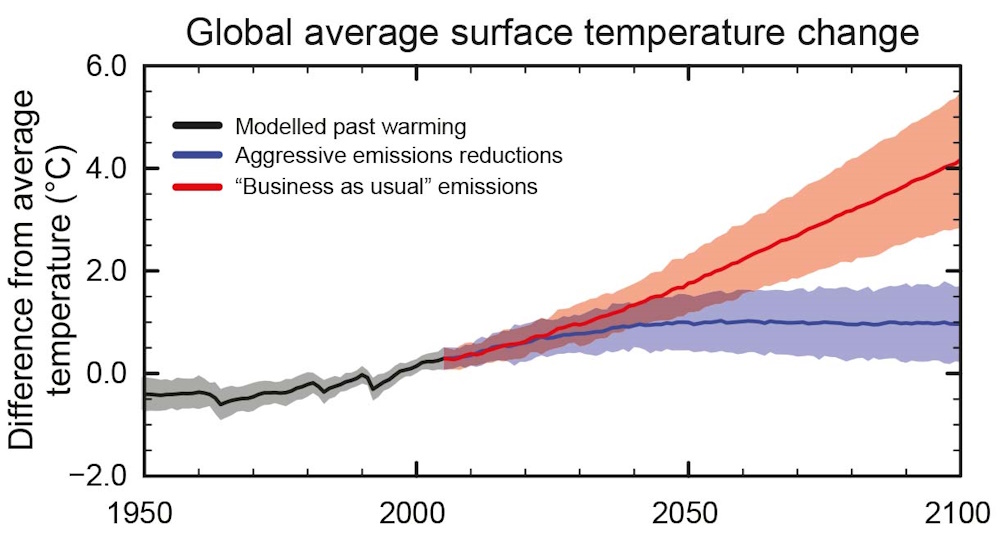
Figure b5. The amount and rate of warming expected for the 21st century depends on the total amount of greenhouse gases that humankind emits. Models project the temperature increase for a business-as-usual emissions scenario (in red) and aggressive emission reductions, falling close to zero 50 years from now (in blue). Black is the modelled estimate of past warming. Each solid line represents the average of different model runs using the same emissions scenario, and the shaded areas provide a measure of the spread (one standard deviation) between the temperature changes projected by the different models. All data are relative to a reference period (set to zero) of 1986-2005. Source: Based on IPCC AR5
